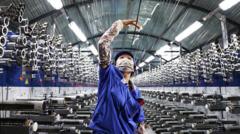Which Asian Economies Suffered Most from Trump’s Tariffs?

Understanding the Impact of Recent Tariffs on Asian Economies
The announcement of tariffs by U.S. President Donald Trump on "Liberation Day" in April sent shockwaves through economies across Asia. Countries with export-driven economies, particularly those relying heavily on the U.S. market, faced significant challenges as they scrambled to negotiate deals before the critical August deadline. This article delves into how various economies in Asia fared in the latest tariff announcements, exploring both the winners and the losers amidst the shifting trade landscape.
Overview of Tariff Impacts
Tariffs are taxes imposed on imported goods, which can significantly affect international trade. The U.S. tariffs, announced at rates as high as 49% for some nations, particularly impacted Asian countries that export a wide range of goods, from electronics to textiles. As Asian economies are typically export-oriented, these tariffs were met with urgent negotiations and strategic maneuvering to mitigate their effects.
The Role of Key U.S. Allies
Among the nations affected, America's key allies, such as Japan and South Korea, demonstrated a proactive approach to negotiations. Initially facing a proposed 25% tariff, both countries managed to negotiate this down to 15% by sending trade delegations to Washington. Their strong military and economic ties with the U.S. likely played a role in securing a more favorable outcome.
On July 22, Trump heralded the agreement with Japan as the "largest trade deal in history," while the deal with South Korea was officially unveiled a week later. This illustrates how diplomatic relationships can influence trade negotiations, potentially shielding allies from more severe penalties.
Taiwan's Semiconductor Sector
Another key player in the semiconductor industry, Taiwan, also experienced a reduction in tariffs from 32% to 20%. However, uncertainty looms over whether its chip sector will face separate tariffs. Taiwan’s President Lai Ching-te noted that the current tariff rate is "temporary," indicating ongoing negotiations with the U.S. that could further impact the economy. Taiwan's advanced technology sector is crucial not just for its economy but also for U.S. tech firms, creating a complex interplay of interests.
Australia and New Zealand's Diverging Futures
Australia, which faced a 10% tariff in April, appears to have avoided an increase for now. In contrast, its neighbor New Zealand saw its tariff rise from 10% to 15%. New Zealand's Trade Minister, Todd McClay, expressed frustration over being "unfairly penalized" and sought discussions with U.S. officials to advocate for a lower tariff rate. This highlights the varying impacts of U.S. trade policies even among closely aligned economies.
The China Factor
China's situation remains complex and largely unaddressed in the latest tariff discussions. Diplomatic talks between Beijing and Washington have intensified recently, with both sides seeking to negotiate terms that could stabilize their trade relations. Key issues include U.S. export controls on technology and China's commitment to increasing purchases of U.S. goods. Despite the absence of announcements regarding new tariffs on China, the ongoing negotiations indicate the potential for future trade agreements that could reshape the economic landscape.
India's Position in the Tariff Landscape
India, often described by Trump as a "good friend," faced a 25% tariff on goods imported into the U.S. Additionally, it incurred an "unspecified penalty" related to its purchases of Russian oil and arms, signaling tension in India-U.S. relations tied to geopolitical alliances. However, this marked a slight reduction from the initial 27% tariff proposed in April, indicating that India is navigating a delicate balance between maintaining its foreign relations and addressing U.S. trade concerns.
South East Asia's Varied Outcomes
The response of South East Asian nations has been notably diverse following the tariff announcements. For instance, Vietnam was the first to negotiate with the U.S., successfully reducing its tariff rate from 46% to 20%. This move set a precedent for other ASEAN countries, demonstrating the importance of swift action in trade negotiations.
Tariff Rates Across ASEAN Countries
Most ASEAN countries, including Cambodia, Indonesia, Malaysia, the Philippines, and Thailand, now face tariffs ranging from 19% to 20%. However, Laos and Myanmar experienced the highest tariffs at 40%, likely due to their limited market access and economic ties with China. This scenario illustrates how differing economic strengths and diplomatic relationships can lead to significantly different tariff outcomes.
Pakistan's Competitive Edge
In South Asia, Pakistan stands out with a tariff rate of 19%, the lowest among its regional counterparts. This relatively favorable tariff is expected to benefit Pakistan's textile industry, which accounts for nearly 60% of its total exports, primarily aimed at the U.S. market. As ties between Pakistan and the U.S. have warmed, particularly during Trump's second term, the lower tariff rate could provide a competitive advantage over its main rivals, India and Bangladesh, which face higher tariffs.
Final Thoughts on Tariff Implications
The recent tariff announcements have far-reaching implications for Asian economies, showcasing a complex interplay of diplomacy, trade, and economic strategy. While some countries have managed to negotiate more favorable terms, others continue to grapple with high tariffs that could stifle their economic growth. It remains to be seen how ongoing negotiations will reshape the landscape and what future tariffs may emerge as a result.
FAQs about Tariffs and Asian Economies
What are tariffs, and how do they affect international trade?
Tariffs are taxes imposed on imported goods, which increase the cost of these goods in the importing country. This can lead to decreased demand for imports, impacting international trade dynamics.
Which Asian countries were most affected by the recent tariffs?
Countries like Laos and Myanmar faced the highest tariffs at 40%, while Vietnam and other ASEAN nations experienced varying rates from 19% to 20%. Key allies like Japan and South Korea successfully negotiated lower rates, highlighting their strategic importance to the U.S.
How do tariffs impact the economies of developing countries?
High tariffs can severely impact developing countries by reducing their export revenues, limiting their access to important markets, and potentially slowing economic growth. This can create challenges in addressing poverty and improving living standards.
What strategies can countries use to mitigate the effects of tariffs?
Countries can engage in diplomatic negotiations to secure lower tariffs, diversify their export markets, and invest in domestic industries to reduce reliance on exports to a single market.
As countries navigate this evolving landscape of tariffs and trade agreements, the ongoing impact on their economies will be a critical area to watch. How do you think these changes will influence global trade dynamics in the coming years? #TradeWars #AsianEconomies #Tariffs
Published: 2025-08-01 06:28:15 | Category: technology



